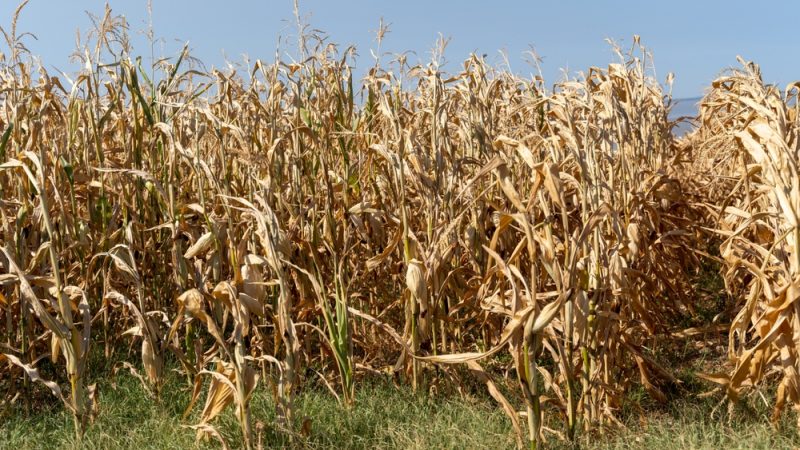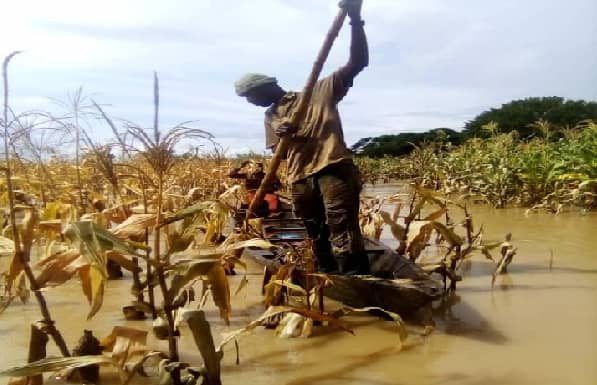Climate Crisis: Perennial floods threatens food security in Savannah Region
It’s about 1:30 pm on Tuesday and Mr. Deseji Kesenaba, a 54-year-old farmer in Busunu in the West Gonja Municipality of the Savannah Region has defied the scorchy sun working in his farm. He is scavenging through the debris of his seven acre maize to salvage some crops after floods occasioned by torrential rainfall submerged the farm in September, 2023. Looking dejected and frustrated, his only wish is to salvage some of the crops to feed his 10 children and wife. He said the crops were virtually ready for harvesting but he lost everything to the month-long floods
“After losing some of my crops to the floods, I wanted to harvest the remaining crops but I couldn’t do so because the farm was cut off by the flood waters” he narrated to Zaa News.
He added that, “my worry now is how to feed my family, because we depend on only the farm produce for feeding and taking care of our children education. This time round, I don’t think I can get even up to a bag of maize, I am just confused”.

A few of Kesenaba’s maize left after floods
The situation is not peculiar to only Mr. Kesenaba as Ibrahim Musah, another farmer in the East Gonja Municipal is also bearing the brunt of the perennial floods. He indicated that he lost his five acres soybeans and maize farm to the disaster in August, adding that they could be possible food shortage due to the devastating impact of the flood.
Mr. Kesenaba and Musah are part of hundreds of farmers in the Savannah and North East Regions counting their losses as a result of the floods.
The spillage of the Akosombo dam in the Volta Region coupled with torrential rainfall have caused floods in the Central Gonja District and East Gonja Municipality in the Savannah Region for the past two months. Hundreds of people have been displaced while property running into thousands of Ghana cedis destroyed.
Flooding in the region has been a perennial situation, however this year’s disaster was very devastating due to the spillage of excess water from the Akosombo Dam coupled with the month-long downpour.
Climate crisis
The perennial floods being experienced in the various communities in the region is a glaring consequences of climate change. It can be attributed to the fast depletion of the fragile vegetation cover by human activities such as indiscriminate tree felling and destruction of water bodies
Situation
In an interview, the Savanah Regional Director of the National Disaster Management Organization (NADMO), Mohammed Tahir, he noted that, the devastation on farmlands by the floods has been very dire. He indicated that, about 9,200 acres of farmlands have been destroyed by floods in the region, with the central Gonja District being the hardest hit. He expressed fear of a possible food shortage as a result of the incident, adding that though some relief items have been presented to the victims since the incident occurred, stringent measures needed to be put in place to avert future occurrence.

“boyan stream” one of the streams some farmers cross to their farms
Adaptation measures
On how to adapt to climate change, an Agriculture Extension Officer, Abraham Kwame Adu, said farmers needed to be educated on proper farming practices that can withstand the change of crisis. He said the change in rainfall pattern this year was expected as the Ghana Meteorological Agency had predicted more rains in the Northern sector of Ghana. While admitting that, the prolonged rains have caused a lot of havoc to some farmers, he said adopting climate change friendly technologies can make life better for farmers.
“Farming across streams will always contribute to what is happening now, when the rains come unpredicted, the roads will always be filled with water and farmers will struggle to transport their farm produce” Mr Adu added.
Food insecurity
In the midst of the disaster, there are concerns of possible food shortage in the area. The Savannah Regional Director of the Department of Agriculture, Alhaji Seidu Sule, said “ based on the figures we have, it may not impact too much on our productivity in the region, but some specific areas in the districts especially the Central Gonja District which is the most affected will experience food shortage”.
He, therefore, called for support to the affected farmers to enable them return to the farm the next farming season.
SDGs/Way forward
Goal two of the Sustainable Development Goals (SDGs) advocates to end hunger and ensure access by all people, in particular the poor and people in vulnerable situations, including infants, to safe, nutritious and sufficient food all year round.
However, achieving the goal looks bleak with the perennial devastation of large tracts of farmlands in the area. To address the situation, there is the need for authorities to step up deliberate measures to mitigate the impact of the annual floods on farmers. Also, they must be supported with farm inputs and finance to enable them to return to the farm for their farming activities.
Source: zaaradio.com/Jonas Biawurbi




